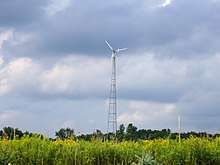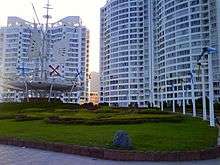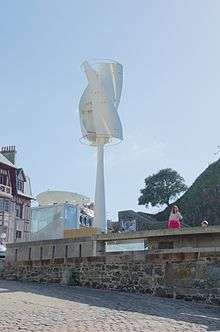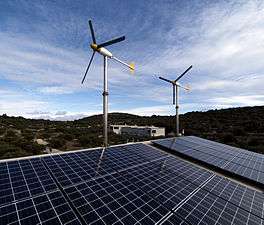Small wind turbine
A small wind turbine is a wind turbine used for microgeneration, as opposed to large commercial wind turbines, such as those found in wind farms, with greater individual power output. The Canadian Wind Energy Association (CanWEA) defines "small wind" as ranging from less than 1000 Watt (1 kW) turbines up to 300 kW turbines.[1] The smaller turbines may be as small as a 50 Watt auxiliary power generator for a boat, caravan, or miniature refrigeration unit. The IEC-61400-2:2013 Standard defines small wind turbines as wind turbines with a rotor swept area smaller than 200 m2, generating at a voltage below 1000 Va.c. or 1500 Vd.c.

Design
Smaller scale turbines for residential scale use are available. Their blades are usually 1.5 to 3.5 metres (4 ft 11 in–11 ft 6 in) in diameter and produce 1-10 kW of electricity at their optimal wind speed.[1] Some units have been designed to be very lightweight in their construction, e.g. 16 kilograms (35 lb), allowing sensitivity to minor wind movements and a rapid response to wind gusts typically found in urban settings and easy mounting much like a television antenna. It is claimed, and a few are certified, as being inaudible even a few feet (about a metre) under the turbine.
The majority of small wind turbines are traditional horizontal axis wind turbines,[2] but vertical axis wind turbines are a growing type of wind turbine in the small-wind market. Makers of vertical axis wind turbines such as WePower, Urban Green Energy, Helix Wind, and Windspire Energy, have reported increasing sales over the previous years.
The generators for small wind turbines usually are three-phase alternating current generators and the trend is to use the induction type. They are options for direct current output for battery charging and power inverters to convert the power back to AC but at constant frequency for grid connectivity. Some models utilize single-phase generators.[3][4]
Some small wind turbines can be designed to work at low wind speeds,[5] but in general small wind turbines require a minimum wind speed of 4 metres per second (13 ft/s).[6]
Dynamic braking regulates the speed by dumping excess energy, so that the turbine continues to produce electricity even in high winds. The dynamic braking resistor may be installed inside the building to provide heat (during high winds when more heat is lost by the building, while more heat is also produced by the braking resistor). The location makes low voltage (around 12 volt) distribution practical.
Small units often have direct drive generators, direct current output, lifetime bearings and use a vane to point into the wind. Larger, more costly turbines generally have geared power trains, alternating current output and are actively pointed into the wind. Direct drive generators are also used on some large wind turbines.
Materials
While natural fibers face quality variations, high moisture uptake and low thermal stability that make them undesirable for larger blades experiencing high amounts of stress, the lower stress small turbines used in rural electrification and small-scale renewable systems can still take advantage of them.[7] Hemp, flax, wood and bamboo are all candidate blade materials for small turbines.[8] Nepal has used small blade turbines made of coated timber and, of the available wood materials including Sal, Saur, Sisau, Uttish, Tuni and Okhar, pine and lakuri wood were identified as performing the best based on their ready availability, cost and growth time average density, high stiffness, and breaking strain.[9] Coatings are also generally used to reduce moisture and white enamel with primer has been found to be particularly effective .[10] Sitka spruce, (used in propellers) and Douglas Fir have also been used in turbine blades.[11]
Beyond wood, bamboo-based composites may also be used in both large and small wind turbines due to their low density and carbon sequestration ability—which makes bamboo materials environmentally friendly. Furthermore, relative to wood, bamboo has higher facture toughness, higher strength, lower processing costs and fast growth rate. Ongoing materials developments include bamboo laminates using resins and hybrid bamboo carbon-fiber materials.[12]
A range of synthetic materials including carbon fiber reinforced polymers, nanocomposites,[13] and E-glass-polyester have also been used.[14]
Installation
Turbines are often mounted on a tower to raise them above any nearby obstacles. One rule of thumb is that turbines should be at least 9 m (30 ft) higher than anything within 150 m (490 ft).[15] Better locations for wind turbines are far away from large upwind obstacles. Measurements made in a boundary layer wind tunnel have indicated that significant detrimental effects associated with nearby obstacles can extend up to 80 times the obstacle's height downwind.[16] However, this is an extreme case. Another approach to siting a small turbine is to use a shelter model to predict how nearby obstacles will affect local wind conditions. Models of this type are general and can be applied to any site. They are often developed based on actual wind measurements, and can estimate flow properties such as mean wind speed and turbulence levels at a potential turbine location, taking into account the size, shape, and distance to any nearby obstacles.[17]
A small wind turbine can be installed on a roof. Installation issues then include the strength of the roof, vibration, and the turbulence caused by the roof ledge. Small-scale rooftop turbines suffer from turbulence and rarely generate significant amounts of power, especially in towns and cities.[18]
Markets
Japan
In July 2012, a new feed-in tariff approved by Japanese Industry Minister Yukio Edano went into effect, promising to boost the country's production of wind and solar energy production. The country is aiming to increase renewable energy investment in part as a response to the Fukushima radiation crisis in March 2011.[19] The feed-in tariff applies to solar panels and small wind turbines and requires utilities to buy back electricity generated from renewable energy sources at government-established rates.
Small-scale wind power (turbines of less than 20 kW capacity) will be subsidized at least 57.75 JPY (about 0.74 USD per kwh).[20]
United Kingdom
Properties in rural or suburban parts of the UK can opt for a wind turbine with inverter to supplement local grid power. The UK's Microgeneration Certification Scheme (MCS) provides feed-in tariffs to owners of qualified small wind turbines.[21]
United States
Small wind turbines added a total of 17.3 MW of generating capacity throughout the United States in 2008, according to the American Wind Energy Association (AWEA). That growth equaled a 78% increase in the domestic market for small wind turbines, which are defined as wind turbines with capacities of 100 kW or less. AWEA's "2009 Small Wind Global Market Study", published in late 2009 May, credited the increase in part to greater manufacturing volumes, as the industry was able to attract enough private investment to finance manufacturing plant expansions. It also credited rising electricity prices and greater public awareness of wind technologies for an increase in residential sale.
In 2019, much of the US demand for small wind turbines was for power generation at remote locations, and for purposes of site assessment for large scale wind power installations.[22]
The U.S. small wind industry also benefits from the global market, as it controls about half of the global market share. U.S. manufacturers garnered $77 million of the $156 million that was spent throughout the world on small wind turbine installations. A total of 38.7 MW of small wind power capacity was installed globally in 2008.[23]
In the United States, residential wind turbines with outputs of 2–10 kW typically cost between US$12,000 and US$55,000 installed (US$6 per watt), although there are incentives and rebates available in 19 states that can reduce the purchase price for homeowners by up to 50 percent, to $3 per watt.[24] The US manufacturer Southwest Windpower estimates a turbine to pay for itself in energy savings in 5 to 12 years.[25][26]
The dominant models on the market, especially in the United States, are horizontal-axis wind turbines.
To enable consumers to make an informed decision when purchasing a small wind turbine, a method for consumer labeling has been developed by IEA Wind Task 27 in collaboration with IEC TC88 MT2. In 2011 IEA Wind published a Recommended Practice, which describes the tests and procedures required to apply the label.[27]
Croatia
Croatia is an ideal market for small wind turbines due to Mediterranean climate and numerous islands with no access to the electric grid. In winter months when there is less sun, but more wind, small wind turbines are a great addition to isolated renewable energy sites (GSM, stations, marinas etc.). That way solar and wind power provide consistent energy throughout the year.
Germany
In Germany the feed-in tariff for small wind turbines has always been the same as for large turbines. This is the main reason the small wind turbine sector in Germany developed slowly. In contrast, small photovoltaic systems in Germany benefited from a high feed-in tariff, at times above 50 Euro-Cent per kilowatt hour.
In August 2014 the German renewable energy law was adjusted, also affecting the feed-in tariffs for wind turbines. For the operation of a small wind turbine with a capacity below 50 kilowatt the tariff amounts to 8.5 Euro-Cent for a period of 20 years.
Due to the low feed-in tariff and high electricity prices in Germany, the economic operation of a small wind turbine depends on a large self-consumption rate of the electricity produced by the small wind turbine. Private households pay on average 28 cent per kilowatt hour for electricity (19% VAT included).
As part of the German renewable energy law 2014 a fee on self-consumed electricity was introduced in August 2014. The regulation does not apply to small power plants with a capacity below 10 kilowatt. With an amount of 1.87 Euro-Cents the fee is low.[29]
DIY construction
Some hobbyists have built wind turbines from kits, sourced components, or from scratch. DIY wind turbines are usually smaller (rooftop) turbines of approximately 1 kW or less.[30][31][32][33] These small wind turbines are usually tilt-up or fixed / guyed towers.[34][35]
Do it yourself or DIY-wind turbine construction has been made popular by magazines such as OtherPower and Home Power.[36]
Organizations as Practical Action have designed DIY wind turbines that can be easily built by communities in developing nations and are supplying concrete documents on how to do so.[37][38]
Locally manufactured small wind turbines
Designs of DIY small wind turbines date back to the early 1970s, and were further developed by the back-to-the-land movement of the late 1970s in the United States and Europe.[39]
In 2000, Practical Action contracted Hugh Piggott, a widely acknowledged expert in small wind energy who, at the time, had more than 20 years of experience in harnessing electricity from the wind in the remote off-grid rural community of Scoraig in Scotland, to prepare a design manual for the local production of 200W small wind turbines in developing countries. In the following years, Hugh Piggott continued improving the design manual himself while organizing hands-on construction workshops in Europe and the United States, where DIY enthusiasts learned how to build complete small wind turbines. Gradually he developed a design which could be locally manufactured with simple benchtop tools and techniques, using mostly locally sourced materials.
In 2008, Piggott published the "A Wind Turbine Recipe Book: The Axial Flux Windmill Plans",[40] a step-by-step manual which describes how to build six small wind turbines of rotor diameters from 1.2 m to 4.2 m (with rated power of 200 W to 3 kW respectively). All materials used in the manufacturing of these wind turbines can be found in the local markets of most medium-sized towns, apart from the magnets, which need to be ordered from specialized online dealers.
A derivative design based on Piggott's manufacturing plans is the book manual of Otherpower from the US, "Homebrew Wind Power: A Hands-On Guide to Harnessing the Wind",[41] which describes a similar design and manufacturing process, but with modifications for more demanding environments. The designs developed by Otherpower are shared through their website and online forum.
Since then, these design manuals have been a reference guide for locally manufactured small wind turbines worldwide. Rural electrification has been the main field of application of this technology, with many non-governmental organizations (NGOs) and groups using the manuals to locally manufacture small wind turbines in developing countries, and several groups organizing construction seminars for DIY enthusiasts around the world. Hugh Piggott’s manual has been translated into more than ten languages and it has been estimated that more than 1,000 locally manufactured small wind turbines have been constructed based on Piggott’s design, and currently many of them are in operation around the world.[39]
The open nature of these designs has given rise to a global community of designers, builders and users that continue to apply and further develop the technology in a bottom-up innovation process, resembling an open-source hardware community. Since 2012, the Wind Empowerment association has managed to network most of the organizations involved with locally manufactured small wind turbines in the world, aiming at empowering the activities of these organizations and at performing joint research and projects while openly sharing knowledge. Considerable interdisciplinary research is also being produced around locally manufactured small wind turbines, studying their technical as well as social, organizational, economic, cultural and environmental aspects,[39][42][43][44][45][46],.[47]
Locally manufactured small wind turbines, being small-scale, low-cost, socially-embedded, adoptive to local contexts and based on the open sharing of knowledge, have been framed under or associated with the perspectives of appropriate or intermediate technology, convivial technology, degrowth, open design and open manufacturing.
In terms of licenses, although the available design manuals are technically open-source, they are not published under a particular commons-oriented license. How a collective design and piece of hardware could be produced and under what license it could explicitly be provided is currently an open question.[48]
See also
- WWEA (World Wind Energy Association)
- Open source hardware
- Wind turbine design
- Grid-tied electrical system
- Ram air turbine
References
- Small Wind Turbine Purchasing Guide (PDF) (Report). Canadian Wind Energy Association. pp. 3–4. Archived from the original (PDF) on 2 March 2013. Retrieved 1 March 2016.
- Gipe, Paul. Wind energy basics: a guide to home- and community-scale wind energy systems. Chelsea Green Publishing, 2009. Accessed: 18 December 2010. ISBN 1-60358-030-1 ISBN 978-1-60358-030-4
- Forsyth, Trudy (20 May 2009). "Small Wind Technology" (PDF). National Renewable Energy Laboratory. Archived from the original (PDF) on 17 March 2013. Retrieved 20 September 2013.
- "Endurance E-3120-50 kW Wind Turbine from Endurance Wind Power". AZoNetwork. 13 May 2010. Retrieved 20 September 2013.
- Luleva, Mila (28 October 2013). "Small-Scale "Dragonfly" Wind Turbine Works at Low Wind Speeds". Green Optimistic. Retrieved 18 September 2015.
- Small Wind Turbine Purchasing Guide (PDF) (Report). Canadian Wind Energy Association. p. 6. Archived from the original (PDF) on 2 March 2013. Retrieved 1 March 2016.
- Kalagi, Ganesh; Patil, Rajashekar; Nayak, Narayan (2016). "Natural Fiber Reinforced Polymer Composite Materials for Wind Turbine Blade Applications" (PDF). International Journal of Scientific Development and Research. 1: 28–37.
- Bron̜dsted, Povl; Nijssen, Rogier P. L., eds. (2013). Advances in wind turbine blade design and materials. Oxford: Woodhead Publishing. ISBN 9780857097286. OCLC 864361386.
- Mishnaevsky, Leon; Freere, Peter; Sinha, Rakesh; Acharya, Parash; Shrestha, Rakesh; Manandhar, Pushkar (2011). "Small wind turbines with timber blades for developing countries: Materials choice, development, installation and experiences". Renewable Energy. 36 (8): 2128–2138. doi:10.1016/j.renene.2011.01.034.
- Sinha, Rakesh; Acharya, Parash; Freere, Peter; Sharma, Ranjan; Ghimire, Pramod; Mishnaevsky, Leon (2010). "Selection of Nepalese Timber for Small Wind Turbine Blade Construction". Wind Engineering. 34 (3): 263–276. doi:10.1260/0309-524X.34.3.263. ISSN 0309-524X.
- Wood, David (2011), "Blade Design, Manufacture, and Testing", Small Wind Turbines, Green Energy and Technology, Springer London, pp. 119–143, doi:10.1007/978-1-84996-175-2_7, ISBN 9781849961745
- Holmes, John W.; Brøndsted, Povl; Sørensen, Bent F.; Jiang, Zehui; Sun, Zhengjun; Chen, Xuhe (2009). "Development of a Bamboo-Based Composite as a Sustainable Green Material for Wind Turbine Blades". Wind Engineering. 33 (2): 197–210. doi:10.1260/030952409789141053. ISSN 0309-524X.
- Thirumalai, Durai Prabhakaran Raghavalu; Kale, Sandip A.; Prabakar, K., eds. (2015). Renewable Energy and Sustainable Development. ISBN 9781634634649.
- Sessarego, Matias; Wood, David (2015). "Multi-dimensional optimization of small wind turbine blades". Renewables: Wind, Water, and Solar. 2 (1). doi:10.1186/s40807-015-0009-x. ISSN 2198-994X.
- Hugh Piggott (6 January 2007). "Windspeed Measurement In The City". Scoraigwind.com. Retrieved 4 December 2011.
- "Wind tunnel measurements near an obstacle". Ntrs.nasa.gov. 15 October 2011. Retrieved 4 December 2011.
- "Development of a Neural Network based Obstacle Wake Model" (PDF). Retrieved 4 December 2011.
- Leake, Jonathan (2006-04-16). "Home wind turbines dealt killer blow". The Sunday Times. UK. Retrieved 2009-07-13.
- "Japan approves renewable subsidies in shift from nuclear power". Reuters. 2012-06-18. Retrieved 18 June 2012.
- "Japan Approves Feed-in Tariffs". Reuters. 2012-06-22. Retrieved 22 June 2012.
- "Feed-In Tariffs Scheme (FITs)". MCS. Retrieved 29 December 2012.
- Casey, Tina (2019-09-19). "What's Up With The Micro Wind Turbines? They're Up!". CleanTechnica. Retrieved 2019-09-21.
- "EERE News: AWEA: U.S. Market for Small Wind Turbines Grew 78% in 2008". Apps1.eere.energy.gov. Retrieved 4 December 2011.
- Shevory, Kristina (13 December 2007). "Homespun Electricity, From the Wind". The New York Times. Retrieved 4 December 2011.
- "Southwest Windpower". Windenergy.com. Archived from the original on 11 January 2012. Retrieved 4 December 2011.
- "Wind Power for Commercial Projects: Case Studies". XZERES. Retrieved 18 September 2015.
- "IEA Wind Home Page". Ieawind.org. Retrieved 4 December 2011.
- "Kako i zašto ostvarujemo najbolje rezultate" (in Hungarian). Veneko. Retrieved 18 September 2015.
- "German Small Wind Turbine Portal". klein-windkraftanlagen.com. Retrieved 4 February 2015.
- "British Wind and Energy Agency's DIY wind turbines page". Bwea.com. Archived from the original on 4 December 2011. Retrieved 4 December 2011.
- "Common FAQs of wind turbine construction and info for proper building". Wind-turbine-24v.com. Retrieved 4 December 2011.
- "Overview of wind turbine construction and info for proper building". Otherpower.com. Retrieved 4 December 2011.
- Diy wind turbine 1kw. Youtube. 7 May 2015. Retrieved 18 September 2015.
- "Smaller wind turbines usually of tilt-up or fixed design". Archived from the original on 1 October 2011. Retrieved 4 December 2011.
- "Modified Chispito Wind Turbine". Greenterrafirma.com. Retrieved 4 December 2011.
- "OtherPower and Home Power as popular diy microgeneration magazines" (PDF). Retrieved 4 December 2011.
- "Practical action producing info to construct DIY wind turbines for the developing world". Practicalaction.org. Retrieved 4 December 2011.
- "Basics on diy small scale windturbines and domestic power consumption" (PDF). Retrieved 4 December 2011.
- Latoufis, Kostas C.; Pazios, Thomas V.; Hatziargyriou, Nikos D. (March 2015). "Locally Manufactured Small Wind Turbines: Empowering communities for sustainable rural electrification". IEEE Electrification Magazine. 3 (1): 68–78. doi:10.1109/MELE.2014.2380073. ISSN 2325-5897.
- Piggott, Hugh. (2009). A wind turbine recipe book : the axial flux windmill plans. Scoraig wind. OCLC 436260557.
- Bartmann, Dan. (2009). Homebrew wind power : a hands-on guide to harnessing the wind. Fink, Dan., Sagrillo, Mick. (1st ed.). Masonville, CO: Buckville. ISBN 978-0-9819201-0-8. OCLC 294885893.
- Mishnaevsky, Leon; Freere, Peter; Sinha, Rakesh; Acharya, Parash; Shrestha, Rakesh; Manandhar, Pushkar (August 2011). "Small wind turbines with timber blades for developing countries: Materials choice, development, installation and experiences". Renewable Energy. 36 (8): 2128–2138. doi:10.1016/j.renene.2011.01.034. ISSN 0960-1481.
- Latoufis, K.C.; Messinis, G.M.; Kotsampopoulos, P.C.; Hatziargyriou, N.D. (August 2012). "Axial Flux Permanent Magnet Generator Design for Low Cost Manufacturing of Small Wind Turbines". Wind Engineering. 36 (4): 411–431. doi:10.1260/0309-524x.36.4.411. ISSN 0309-524X.
- Neves, Pedro; Gleditsch, Morten; Bennet, Cindy; Craig, Mathias; Sumanik-Leary, Jon (2015). "Assessment of locally manufactured small wind turbines as an appropriate technology for the electrification of the Caribbean Coast of Nicaragua". AIMS Energy. 3 (1): 41–74. doi:10.3934/energy.2015.1.41. ISSN 2333-8334.
- Alsop, Alfred; Eales, Aran; Strachan, Scott; Leary, Jon; Persson, Jon; Almeyda, Isabel Ruiz (October 2017). "A global market assessment methodology for small wind in the developing world" (PDF). 2017 IEEE Global Humanitarian Technology Conference (GHTC). IEEE: 1–6. doi:10.1109/ghtc.2017.8239226. ISBN 978-1-5090-6046-7.
- Troullaki, Aikaterini; Latoufis, Kostas; Marques, Pedro; Freire, Fausto; Hatziargyriou, Nikos (September 2019). "Life Cycle Assessment of Locally Manufactured Small Wind Turbines and Pico-Hydro Plants". 2019 International Conference on Smart Energy Systems and Technologies (SEST). Porto, Portugal: IEEE: 1–6. doi:10.1109/SEST.2019.8849074. ISBN 978-1-72811-156-8.
- Leary, J.; While, A.; Howell, R. (April 2012). "Locally manufactured wind power technology for sustainable rural electrification". Energy Policy. 43: 173–183. doi:10.1016/j.enpol.2011.12.053.
- Kostakis, Vasilis; Latoufis, Kostas; Liarokapis, Minas; Bauwens, Michel (October 2018). "The convergence of digital commons with local manufacturing from a degrowth perspective: Two illustrative cases". Journal of Cleaner Production. 197: 1684–1693. doi:10.1016/j.jclepro.2016.09.077.
Further reading
- Dan Fink; Dan Bartmann (2008). Homebrew Wind Power. Buckville Publications LLC. ISBN 978-0-9819201-0-8.
External links
| Wikimedia Commons has media related to Micro-generation wind turbines. |
- information about small wind market by WWEA
- Bladeless wind turbine
- A Dutch government test of 10 wind turbines (English summary: , )
- Make small wind turbine at home Complete video and image Guide by Newphysicist
- Challenges of Introducing Reliable Small Wind Turbines
- Fact sheet from the American Wind Energy Association
- Otherpower, a group of alternative energy enthusiasts
- An example of DIY small wind turbine


